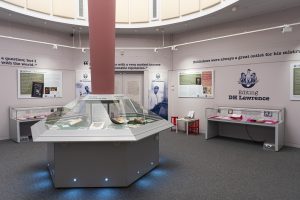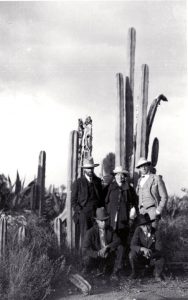May 20, 2022, by Kathryn Steenson
Prose Responses to Editing DH Lawrence
On 5 May 2022, 14 writers from the Writer Highway group, led by Cathy Grindrod, were invited to respond to our exhibition Editing DH Lawrence. Here are the prose responses, check our other blog-post for poetic responses!
D.H. Lawrence Exhibition, Lakeside by Bobbie Prime [including 4 poems by DH Lawrence]
The exhibition revealed how hypocritical was the response by the establishment to Lady Chatterley’s Lover. One has to wonder if class played as big a part in the shock the book gave to the establishment as much as the frankness about sex. The furore over the publication now seems so dated. Had it been published today, the depictions of sex would seem mild in comparison with many of today’s publications. In fact, perhaps we have gone too far in the opposite direction with the range of pornography now available in books, films and websites. I remember the first time I read the book I found it hilarious rather than shocking.
The exhibition gives several interesting insights into the process of Lawrence’s writing.
It was fascinating to see the amount of editing his writing went through; he was constantly rethinking, rewriting – a process that any writer needs to go through.
I found it very interesting that Lawrence said:
“a writer should have the courage to reflect on the skeletons in one’s own cupboard …. thinking about oneself is the greatest thing for a writer, especially when you feel you have spoken to your skeleton.”
The inspiration for many writers often involves the exploration of their skeletons.
I think the excessive emphasis that there has been on Lady Chatterley’s Lover distorts Lawrence’s contribution to British Literature. I think Sons and Lovers and the Rainbow are far greater novels and will survive the test of time more than Lady Chatterley. The characters in these novels are less stereotyped than in lady C and Lawrence’s descriptions of landscape are rich and poetic.
His creation of the “country of my heart” in both novels and his poetry has always resonated strongly with me; I grew up in the same area and loved, like Lawrence, to escape for my ugly little mining town into the gentle, timeless surrounding countryside. His essay on Nottingham and the Mining Country wonderfully encapsulates this region.
I would love to see another exhibition which explores Lawrence the poet. Whereas the novels now to me seem rather dated, many of his poems are extremely beautiful and seem so modern and relevant to our current concerns for conserving the natural world. Like Gerard Manley Hopkins, Lawrence rejoices in the individuality of creatures and flowers. He had a passion for the preciousness of the natural world which he creates with startling individuality.
Mountain Lion
And I think in this empty world there was room for me
and a mountain lion.
And I think in the world beyond, how easily we might
spare a million or two of humans
And never miss them.
Yet what a gap in the world, the missing white frost face
of that slim yellow mountain lion!
Snake
And I thought of the albatross,
And I wished he would come back, my snake.
For he seemed to me again like a king,
Like a king in exile, uncrowned in the underworld,
Now due to be crowned again.
And so, I missed my chance with one of the lords
Of life.
And I have something to expiate:
A pettiness.
Bat
Dark air-life looping
Yet missing the pure loop …
A twitch, a twitter, an elastic shudder in flight
And serrated wings against the sky,
Like a glove, a black glove thrown up at the light,
And falling back.
Storm in the Black Forest
Now it is almost night, from the bronzy soft sky
jugful after jugful of pure white liquid fire, bright white
tipples over and spills down.
Editing the ‘Editing D. H. Lawrence’ exhibition by Ros Horsley
“I certainly don’t get on very well with the world.” (D H Lawrence)
Even in 2022, it took four months to curate this tribute to a literary lion of Nottingham. As the books, letters, paintings and poetry show, he clearly did not censor himself in outing his inner anger and frustration.
What did he really feel about being educated at the Nottingham Boys’ High School while his Eastwood contemporaries stayed local? Did he suffer rejection in being between those two worlds? Is this what ignited the fire of his phoenix?
The letters of people in his life speak of his rejection of them and the people of Eastwood did not enjoy the way he portrayed them in such painstaking detail.
Even in 2022, this wealth of literary material needs to be edited for an inclusive audience, the right painting chosen for all ages. The children’s corner has the outline of his own logo design, a phoenix, to colour in. Maybe that’s it. Maybe he was consumed by his own fire and anger. Maybe.
Untitled by Dawn Simpson
Passing under fragrant blossom and walking over sun dappled grass into the foyer of the Weston Gallery at Lakeside, you will be faced with a small unassuming semi-lit room. Step inside and you enter an intimate kaleidoscope featuring elements of the life and works of D H Lawrence.
Glass cabinets become time capsules of intrigue, with enticing flavours of the man, his life, work, loves, inspirations, thoughts, passions and adventures. Alongside this the restrictions he faced on and off the page. Inside those cabinets are rare editions, manuscripts and special collections but so very much more. All a very long way from his humble beginnings in Eastwood.
There are images of the man himself, Lawrence in a heavy tweed 3 piece suit and hat, looking dashingly handsome, distinguished and proud, with a finely chiselled bearded face, piercing gaze and a mop of auburn hair. There he stands, oozing charisma in a group photo with two men of colour, and his wife posing in front of towering cacti near New Mexico. The photo could be a still from a Wild West movie.
Nearby is a poncho reputably worn by Lawrence, it is tightly woven in Navajo style. The poncho has a strong spiritual presence, a quiet dignity and as I gaze, studying its weave, my eyes fill with tears.
The poncho has bold stripes around the perimeter and a zigzag pattern and small narrow vertical stripes across the breast. I am mindful of mountains, rivers, pathways, of arrows, trees and men. I read on and learn that in his poem ‘Whatever man makes’ (1929), Lawrence addresses the Navajo tradition of weaving a loose thread into work to let the soul of the maker escape. The weave of this exhibition is one of life …
Discourse about sex, pornography and censorship, is sensitively embedded in this collection demonstrating editorial, government and legal interventions and controls that Lawrence’s work was subjected to, and the measures he took, in turn, to overcome these barriers to maintain the integrity of his work, and ensure its production and distribution. I learn that Lawrence argued that pornographic art is that which writes by insinuation and suggestion, rather than treating sex openly.
Entering this exhibition as a novice you may ponder on the following:
What happened in the Rue de Cardinal in Paris?
What part did Italy play?
Why did the Home Office instruct the Police to intercept and confiscate parcels in the post?
What words in the text were considered a breach of law?
Who were the subscribers patiently waiting to receive their parcels?
What prompted Lawrence to visit Mexico?
How do you build a picture of a man after he is gone? Perhaps like a Navajo weaver who leaves a loose thread so that their soul is not entirely captured in their items of creation, but can depart intact to begin its next journey.
Untitled by Maureen Haslam
With a group of writers I visited the D.H Lawrence exhibition at Nottingham University.
We were made very welcome by Rebecca, who guided us around the books, paintings and treasures describing the life of D H Lawrence.
I was born in Eastwood, so was very interested in the items from his early life, recognising important buildings around the Town and surrounding areas.
One of the most interesting things was a poncho, hand-made, beautiful clothing worn by him on his travels abroad. Fascinating letters, sketches and paintings.
On the whole it is a Not To Be Missed visit.
Thanks to Rebecca and all the team at the University.
Editing DH Lawrence runs at Lakeside Arts until the 29 May.
No comments yet, fill out a comment to be the first





Leave a Reply